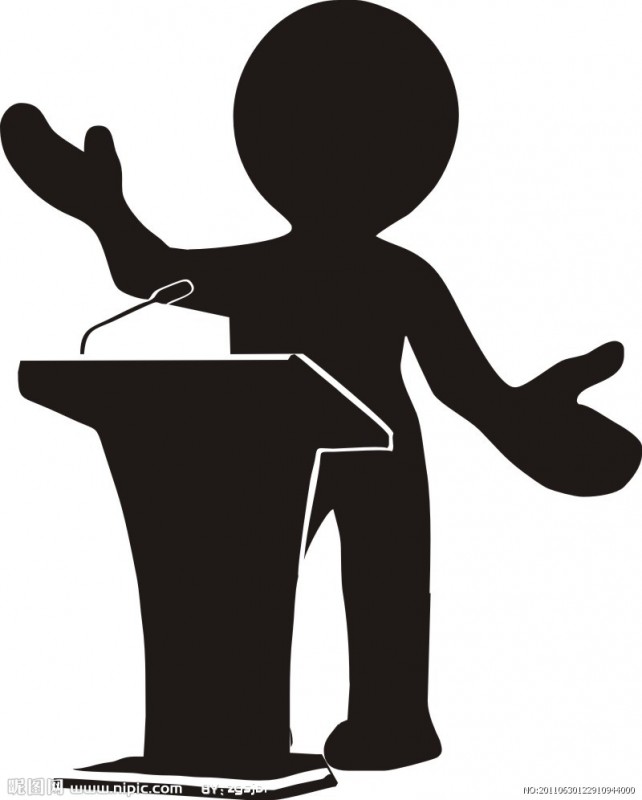开发者演讲指南
2012-09-07总体上来讲,开发者不喜欢做演讲。事实上他们很害怕演讲。不幸的是,演讲是非常重要的。如果没有出色的演讲,大部分人都不会有好的职业发展。有些人 可能有勇气去讲,但是没有相应的指导,不能很好的表达。不管怎样,学习演讲的技巧总比学习一项新的技术要容易。而且你学习一次,就能不断的受益。这篇文章 给出了一些演讲技巧,你可以选择一部分学习。
创建演讲幻灯片
– 要有主线,流程要顺畅
– 不要在一个幻灯片中放太多信息
– 去掉多余的动画
– 要针对听众选择措辞,避免过于技术化
– 制作完成幻灯片后要讲一遍看看流程是否通
– 让其他人来给幻灯片提意见
– 如果需要做演示,为操作创建一个大纲,例如“搜索 joe”
演讲之前
– 提前至少15分钟到会场准备演讲,以防未知的问题
– 如果需要做演示,提前打开程序
– 在链接投影仪的时候选择扩展屏幕,这样你有一块工作区域对外是不可见的
– 选择正确的着装
开始演讲
– 准时开始不要等待迟到的听众。如果演讲延迟,请向听众解释。
– 如果必要的话,先做一个简单的自我介绍。
– 描述演讲的内容,解释会讲什么,不会讲什么。开头要简明扼要。
– 如果允许提问的话,请告诉听众时间和提问形式。
– 根据演讲的形式,你可以要求静音手机或者禁止使用笔记本等等。
演讲进行中
– 不要朗读幻灯片,你要讲故事。故事可以加强辩证的思维,并且吸引听众。
– 在开口之前思考,并且保持冷静。
– 在重要的陈述后简短暂停。这样可以让听众有时间消化。
– 保持眼神交流,关注听众或者不同的个体,而不是你的幻灯片。
– 避免“嗯…”,“啊…”等口头语。
– 避免不必要的动作。
– 演讲中出现状况勇于于承认,并道歉。
演讲中提问
– 不要让对话远离主题
– 假如对话需要很长时间,需要说明,并且礼貌的表达要求会后交流
– 不要让几个对话同时进行。
– 提供简单明确的回答。
– 如果提问不能被回答,请明确说明,并指出什么时候能回答。
结束演讲
– 总结演讲的要点,加深听众的印象。
– 总结一旦开始,不要添加额外观点。
– 如果提问是在最后,请提前结束演讲留足之间给提问。
– 提前几分钟结束演讲,并感谢听众的到场。
原文链接,OSChina.NET 编译
A Developer’s Guide to Presentations
In general, developers do not like to give presentations. In fact, they dread it. This is unfortunate because presentations can be a powerful asset. Most individuals cannot survive a long career without presenting on occasion. Others may have the courage but lack the proper guidance to present effectively. Whatever the circumstance, developing good presentation skills is easier than learning a new technology. The process rarely changes. Learn it once and reap the benefits. The following sections provide a few guidelines for delivering better presentations. To avoid overload, implement only a few at a time.
Building the Presentation
- Start with a strong storyline. Proper flow during a presentation is important.
- Do not place too much information on a slide. It can overload users and the text may be too small for projectors.
- Avoid excessive animations; they distract from the presentation.
- Based on the audience, avoid words that may be too technical.
- When finished, review the slides. Talk through them to verify the flow.
- To reduce inattentional blindness, ask someone else to review the slides.
- If a demo is required, build an outline with specific actions such as: search for ‘Joe’. This eliminates unexpected results.
Before the Presentation
- Arrive at least 15 minutes early to set up the presentation. This allows time for problems and dry runs.
- If a demo is required, load the necessary applications ahead of time. This reduces wait times during the presentation.
- When connecting to a projector, choose to extend the display instead of projecting the desktop. This provides a work area not visible to the audience.
- Choose clothing that complements the presentation. Avoid distracting accessories.
Starting the Presentation
- Start the meeting on time. Do not wait for attendees or reward tardiness. If the presentation is delayed, explain the reasoning to the audience.
- If necessary, start with a simple introduction.
- Define what the presentation will and will not cover. Keep the intro short and to the point.
- If questions are permitted, advise the audience of the proper time and format.
- Depending on the presentation, request that cell phones be silenced and disallow the usage of laptops/tablets.
During the Presentation
- Do not read slides, tell a story. Stories supplement analytical thinking and further engage audiences.
- Think before speaking and remain calm.
- Provide an extended pause after important statements. This provides an opportunity for understanding and saturation.
- Maintain continuous eye contact. Focus on everyone or individuals but do not focus on the slides.
- Try to avoid “ums” and “uhs.” A simple pause is better.
- Avoid distracting movements; physiology is important.
- Take responsibility by apologizing for any problems during the presentation.
Questions During the Presentation
- Do not let a conversation veer too far from the main topic.
- Identify when a question or conversation requires additional time and respectfully set it aside.
- Do not allow multiple conversations at once.
- Provide clear and concise answers.
- If an answer is not available, be honest and direct. Define how and when the question will be answered.
Finishing the Presentation
- Summarize the key points of the presentation. Leave the audience with the proper thoughts and impressions.
- Once summarization has started, do not add new points to the conversation.
- If questions are held until the end, stop early to provide adequate time.
- If necessary, build a list of take-aways and define ownership.
- Finish the presentation a few minutes early and thank the audience for their time.

发表评论